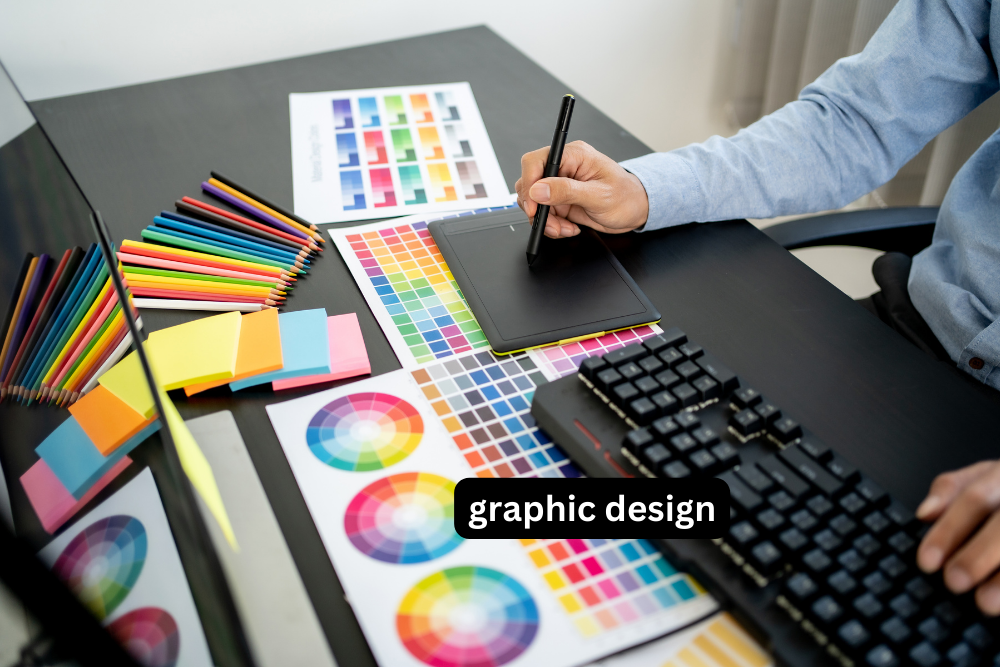Graphic design is a dynamic and ever-evolving field that combines creativity, technology, and strategy to communicate ideas visually. From branding and advertising to web design and user experience, graphic design plays a crucial role in shaping how we perceive and interact with the world. This guide will explore the fundamentals of graphic design its various disciplines, essential tools, and tips for creating impactful designs.
1. What is Graphic Design?
Graphic design is the art of creating visual content to communicate messages. It involves the use of typography, imagery, color, and layout to convey ideas effectively. Graphic designers work across various mediums, including print, digital, and social media, to create designs that are both aesthetically pleasing and functional.
1.1 The Purpose of Graphic Design
-
Communication: Graphic design helps convey complex ideas in a simple and visually appealing way.
-
Branding: It establishes a visual identity for businesses and organizations.
-
Engagement: Well-designed visuals capture attention and encourage interaction.
-
Problem-Solving: Designers use creativity to address challenges and meet user needs.
2. Key Elements of Graphic Design
Understanding the core elements of graphic design is essential for creating cohesive and effective visuals.
2.1 Typography
Typography refers to the art of arranging text in a visually appealing way. It includes font selection, size, spacing, and hierarchy. Good typography ensures readability and enhances the overall design.
2.2 Color Theory
Color is a powerful tool in graphic design. It evokes emotions, creates contrast, and establishes brand identity. Understanding color theory—such as complementary, analogous, and monochromatic color schemes—is crucial for effective design.
2.3 Imagery
Images, illustrations, and icons add depth and context to designs. High-quality visuals can make a design more engaging and memorable.
2.4 Layout and Composition
The arrangement of elements on a page or screen is critical for creating balance and guiding the viewer’s eye. Principles like alignment, proximity, and contrast help create harmonious designs.
2.5 Whitespace
Whitespace, or negative space, is the empty area around design elements. It helps reduce clutter, improve readability, and create a sense of elegance.
3. Types of Graphic Design
Graphic design encompasses a wide range of disciplines, each with its own focus and applications.
3.1 Branding and Identity Design
This involves creating logos, color palettes, and visual guidelines that represent a brand’s personality and values.
3.2 Print Design
Print design includes creating materials like brochures, posters, business cards, and packaging. It requires an understanding of print production techniques.
3.3 Digital Design
Digital design focuses on creating visuals for websites, apps, and social media. It often involves user experience (UX) and user interface (UI) design.
3.4 Motion Graphics
Motion graphics combine graphic design with animation to create engaging videos and interactive content.
3.5 Environmental Design
This type of design focuses on creating visuals for physical spaces, such as signage, murals, and exhibitions.
4. Essential Tools for Graphic Designers
Graphic designers rely on a variety of tools to bring their ideas to life.
4.1 Adobe Creative Suite
-
Photoshop: For photo editing and digital painting.
-
Illustrator: For vector graphics and illustrations.
-
InDesign: For layout design and publishing.
4.2 Canva
A user-friendly tool for creating social media graphics, presentations, and more.
4.3 Figma
A collaborative tool for UI/UX design and prototyping.
4.4 Procreate
A popular app for digital drawing and illustration on iPads.
5. Principles of Effective Graphic Design
To create impactful designs, follow these key principles:
5.1 Balance
Ensure that elements are distributed evenly to create visual harmony.
5.2 Contrast
Use contrasting colors, sizes, and shapes to make elements stand out.
5.3 Alignment
Align elements to create a clean and organized layout.
5.4 Repetition
Repeat design elements to create consistency and reinforce branding.
5.5 Proximity
Group related elements together to create a sense of unity.
6. The Role of Graphic Design in Marketing
Graphic design is a cornerstone of successful marketing strategies. It helps businesses:
-
Build brand recognition.
-
Communicate value propositions.
-
Drive customer engagement.
-
Increase conversion rates.
6.1 Social Media Graphics
Eye-catching visuals are essential for standing out on platforms like Instagram, Facebook, and LinkedIn.
6.2 Advertising
From billboards to online ads, graphic design plays a key role in capturing attention and conveying messages.
6.3 Web Design
A well-designed website enhances user experience and builds trust with visitors.
7. Trends in Graphic Design
The field of graphic design is constantly evolving. Here are some current trends:
7.1 Minimalism
Clean, simple designs with ample whitespace are increasingly popular.
7.2 Bold Typography
Large, expressive fonts are being used to make a statement.
7.3 3D Design
Three-dimensional elements add depth and realism to designs.
7.4 Sustainability
Eco-friendly design practices, such as using recycled materials and sustainable printing methods, are gaining traction.
8. Tips for Aspiring Graphic Designers
If you’re new to graphic design, here are some tips to help you get started:
8.1 Learn the Basics
Master the fundamentals of design, including color theory, typography, and composition.
8.2 Build a Portfolio
Showcase your best work to demonstrate your skills and creativity.
8.3 Stay Inspired
Follow design blogs, attend workshops, and explore other designers’ work for inspiration.
8.4 Practice Consistently
The more you design, the better you’ll become. Experiment with different styles and techniques.
8.5 Seek Feedback
Share your work with peers and mentors to gain constructive criticism.
Conclusion
Graphic design is a multifaceted discipline that blends art, technology, and strategy to create compelling visuals. Whether you’re designing a logo, a website, or a social media post, understanding the principles and tools of graphic design is essential for success. By staying informed about trends, practicing regularly, and seeking inspiration, you can create designs that not only look great but also communicate effectively. As the world becomes increasingly visual, the demand for skilled graphic designers will continue to grow, making it an exciting and rewarding career path.
